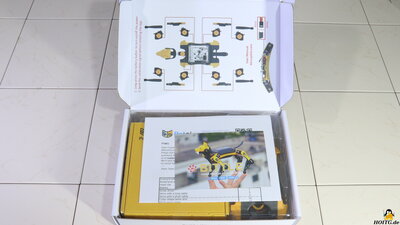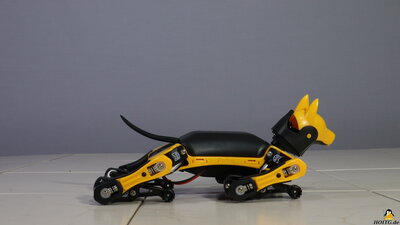| <<< Double H bridge from PCBWay v1.3 | Subjectindex >>> |
Robot dog "Bittle" from Petoi
The gadget in moving pictures with audio
You can buy Bittle via the online shop of Petoi.
You can get 10% off with the coupon code HOITG10 that is active from Aug 13 till Sept 9th 2022.
How Open Is This Gadget?
| Category | Remark | Info |
|---|---|---|
| Firmware |
The Arduino sketch of the firmware, including all libreries is available for Download. |
? |
| Software |
Can be programmed via the Arduino IDE. Smartphone app is Closed Source. No registration for smartphone app needed. |
? |
| Hardware |
All parts are held in place by Phillips screws or snap-in mounts. Spare parts are available via the manufacturer. |
? |
| Electronics |
Mainbioard is an Arduino UNO clone, based on an ATmega328P. |
? |
| Website |
Lots of documentation on assembly, operation and programming. |
? |
| Patente |
Petoi doesn't claim patents on the robot dog. |
? |
The source code of the firmware is available as download on Github.
About the gadget
Figure 1:The electromechanical four-legged friend called "Bittle" comes from the company Petoi. Totally in the spirit of "How Open Is This Gadget?" is that Petoi also is an advocatr of the open source philosophy. Like all Petoi robots, Bittle runs with open source firmware and can be operated and programmed using open source software.
The target group are curious people who already have some experience in programming but now want to delve deeper into the world of bits and bytes.
The joints are designed in such a way that a too high mechanical load is absorbed and parts can simply be snapped back into place. If the worst comes to the worst, spare parts can be ordered from the manufacturer's website, which means that repairs can also be carried out, which is totally in the spirit of open hardware.
Technical data
| Category | Value | Remark |
|---|---|---|
| Dimensions |
200x145x110mm |
Standing |
| Weight |
290g |
|
| Servos |
9x P1S Voltage: max. 8.4V Torque: 3kg*cm |
|
| Battery | Li-Ion, 7.4V 1000mAh | |
| Microcontroller | ATMega328P | |
| Sensors |
6-Axis MPU6050 |
|
| Interfaces | Serial UART, I2C network, infrared receiver, buzzer, WLAN, Bluetooth |
Package contents
Figure 2:You can order Bittle fully assembled or, as seen here, in a kit version.
Assembly
Figure 3:The assembly instructions available on the Internet are very detailed, so that this process is done rather quickly. There are just two remarks on the assembly process from me:
First: Take a really close look at the photos of the various construction stages, because that will speed up the assembly - I was a bit sloppy and and so had to undo and repeat some of the steps.
The second point is the small screwdriver: With that it is a bit tricky to tighten the screws with the self-tapping threads - at least that's easier when you do it for a second time.
Electronics
Figure 4:The main board is based on an Arduino UNO clone and can therefore be easily programmed with the Arduino IDE.
The nine micro-servos that move the joints are no standard devices, because the case is beveled on one side to get the compact design needed for the tiny robotic dog. A look at the inner components shows a metal gear, which means that the tiny drives should have a long service life.
Tricks
Figure 5:A few of the tricks Bittle has embedded in his silicon-based brain from birth.
My conclusion
Petoi has implemented a lot of clever solutions in the design of "Bittle". You get a very robust, well-functioning four-legged robot. If you are willing to learn more on the kinematics of these special type of robots, with "Bittle" you can purchase a complete package of really good hardware with open source software and very extensive documentation, that makes no use of exotic electronic components.The firmware is too complex for beginners when it comes to programming, but those who already have gained some basics on I2C communication or gyroscopes can deepen their knowledge with the robot dog and delve into topics such as "machine Learning".
| <<< Double H bridge from PCBWay v1.3 | Subjectindex >>> |




